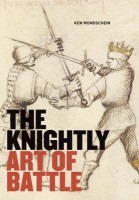Sometimes -- just sometimes -- on a nice summer day, one likes to sit quietly on their own at a wee Bistro table with a view of the street, sipping at one’s coffee (black, thank you very much), and concentrate on looking at pretty things. This book qualifies as that "pretty thing".
Ken Mondschein has edited the most complete of Fiore dei Liberi’s The Flower of Battle manuscripts to produce this gorgeously reproduced selection of some of the better or more interesting plates. And as an added bonus, most plates are accompanied by short descriptive texts written by a modern scholar who practices medieval swordplay and actually fights his subject! Mondschein has previously edited and translated two Renaissance swordplay works, teaches Renaissance history, is an accredited Olympic-style fencer, and instructed HEMA with the Higgins Armory Museum until it closed in 2013.
In the editor's own words, “This book is not meant as an exhaustive guide to the martial system of Fiore, nor as a full scholarly exploration of his work and its meaning in a historical context. Rather, it is intended to serve as a visual tour of the Getty manuscript…” (21).
So then, if it’s not a "Fechtbücher", what is it?
The complete Flower of Battle is not a how-to manual. You could not pick it up and learn by reading how to fight. It is, however, an aide-memoire with which you might jog your memory about what you learned in person with a Master at Arms. Additionally, it may recommend additions to, or amendments of, basic fighting moves that you were already familiar with and practised in:
Fiore does not address such basic subjects as how to parry, feint, or strike – subjects that any modern fencing master would recognise as fundamental to teaching someone how to fence. Nor does he attempt to explain an overall theory of fencing. Rather, his work, like other medieval fencing books, was originally intended as a memorial, a reminder of teachings that would have been transmitted in person to select individuals... (18).
Within Mondschein's selection, however, you’ll see a representation of period sword and wrestling guards, proper use of hafted weapons and weapons on horseback, and "aim here" drawings that are useful for both the advanced student (as if to say, "here is how to do this move properly,") and the lay-person (along the vein of, "See, this is what the WMA is all about!"). Selections from Fiore include his comments on fully-armoured events as you would see in war or a duel, and "mufti"-dress ones in which you would be more concerned with self-defence. The Master’s figures, drawn with meticulous attention to detail, position, and implied movement, allow the viewer to easily follow the ‘action’ on paper, and know immediately who is doing what to whom.
Personally, I quite enjoyed the fact that "how to defend yourself while sitting quietly" (32) was apparently enough of a problem in medieval times to merit its own page!
This is a near-perfect work for you and your peers to discuss the finer points of a salle lesson over a street-side, post-workout coffee… or beer!
Work Cited
Mondschein, K. The Knightly Art of Battle. Los Angeles CA: J. Paul Getty Trust, 2011. 128 pages. ISBN: 1606060767. Available within the Academie Duello Bookstore.
